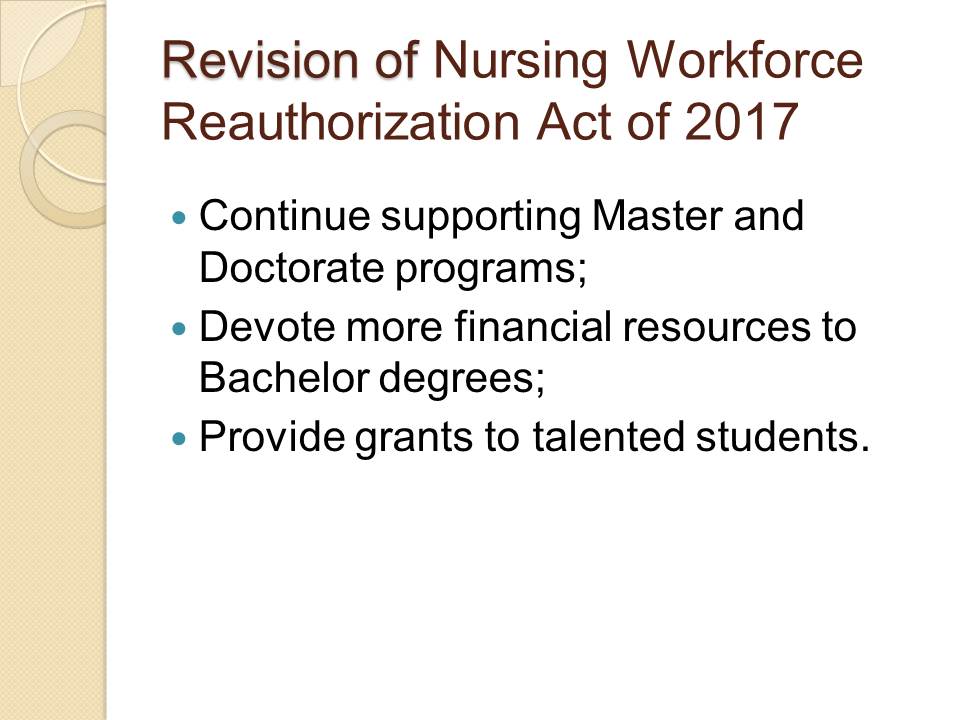Introduction: Roles of a Nurse
Initial:
- Medical specialist and professional.
Additional:
- Social example (Salmond & Echevarria, 2017);
- Role model (Sun et al., 2015);
- Political leader.
Issues with financing nursing education while paying vehement attention to Nursing Workforce Reauthorization Act of 2017 and its revision. Nowadays, being a nurse implies not only providing high-quality care but also being a social example, role model, and political leader (Salmond & Echevarria, 2017; Sun et al., 2015). Thus, education in this sphere continues changing its focus and pays more attention to the social side of the profession, but, clearly, the government does not devote enough financial resources to resolve this problem, and I would like to address this problem from a perspective of a nurse.

Overview & History
- 2007-2008 – The National Advisory Council on Nurse Education and Practice (NACNEP) reviewed educational requirements (NACNEP, 2010);
- 1980 – The Independence Foundation (IF) provided $1 million (Hansen-Turton, Sherman, & King, 2015);
- 1980 – Funding was extended to $9 million;
- 1993-2003 – The IF covered nurse-managed health centers;
- 1998 – Reduction of financing;
- 2017 – Nursing Workforce Reauthorization Act of 2017 (US Senate Committee on Health, Education, Labor, and Pensions, 2017).
To establish a foundation for discussion, this problem was under strong debate since the development of the nursing profession. The growing number of hospitalized patients led to the rising demands for nurses while the shortage of workforce in the healthcare industry along with high maintenance costs continued to be the major problems of the industry (NACNEP, 2010). To fill these gaps, the management started paying more attention to professional characteristics of a nurse and his/her education and knowledge. Consequently, education became of paramount importance, and in 2007-2008, The National Advisory Council on Nurse Education and Practice (NACNEP) reviewed educational requirements and suggested highly valuable recommendations that continue to be regularly revised today (NACNEP, 2010).
Thus, another challenge linked to nursing education was highly connected to the fact that not all individuals were able to afford it. To address this matter, in 1980, the Independence Foundation (IF) provided $1 million to support nursing students while during the same year, the program was extended up to $9 million (Hansen-Turton, Sherman, & King, 2015). In 1993-2013, the funding was expanded to nurse-managed health centers while in 1998, funding was limited due to changes in healthcare legislation and budget deficit (Hansen-Turton et al., 2015). Similar problems have a tendency to exist today, and being highly dependent on national economy strongly worsens this situation. Recently, Nursing Workforce Reauthorization Act of 2017 was introduced to prolong funding of nursing education until 2022, but it still did not fill all the existent gaps (US Senate Committee on Health, Education, Labor, and Pensions, 2017). Overall, this problem is of paramount importance since advancing nursing education can have a beneficial impact on the quality of the provided services, minimize shortage of nurses, and make nurses more patient-orientated.
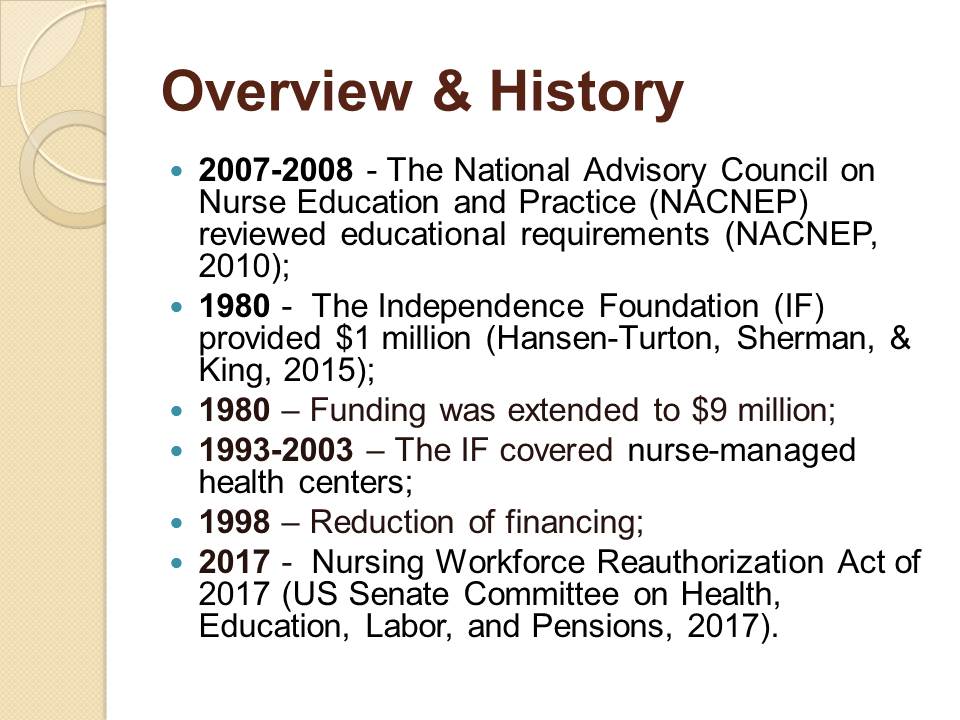
Key Points: Decreasing Number of Uninsured
- Increasing number of individuals over 65 (American Nurses Association, 2016);
- Average age of nurses: 42 (2000) and 44 (2010) (American Nurses Association, 2016).
Previous slides provided only a general overview of the lack of financing for nursing education. Nonetheless, one of the major consequences of this matter is the shortage of nurses. It incurs due to the growing number of individuals over 65 years old, and it implies that more medical assistance will be required (American Nurses Association, 2016). Meanwhile, the Affordable Care Act also had a dramatic impact on this segment, as it strongly decreased the percentage of uninsured individuals from 18.2% in 2010 to 10.5% in 2015 (see Figure 1) (Kaiser Family Foundation, 2016). As a consequence, a combination of these changes in the healthcare industry along with rising accessibility of medical assistance required to have more medical professionals in this area while driving nursing shortage. For example, currently, the industry does not have enough young professionals since the average age of nurses increased from 42 (2000) to 44 (2010) (American Nurses Association, 2016).
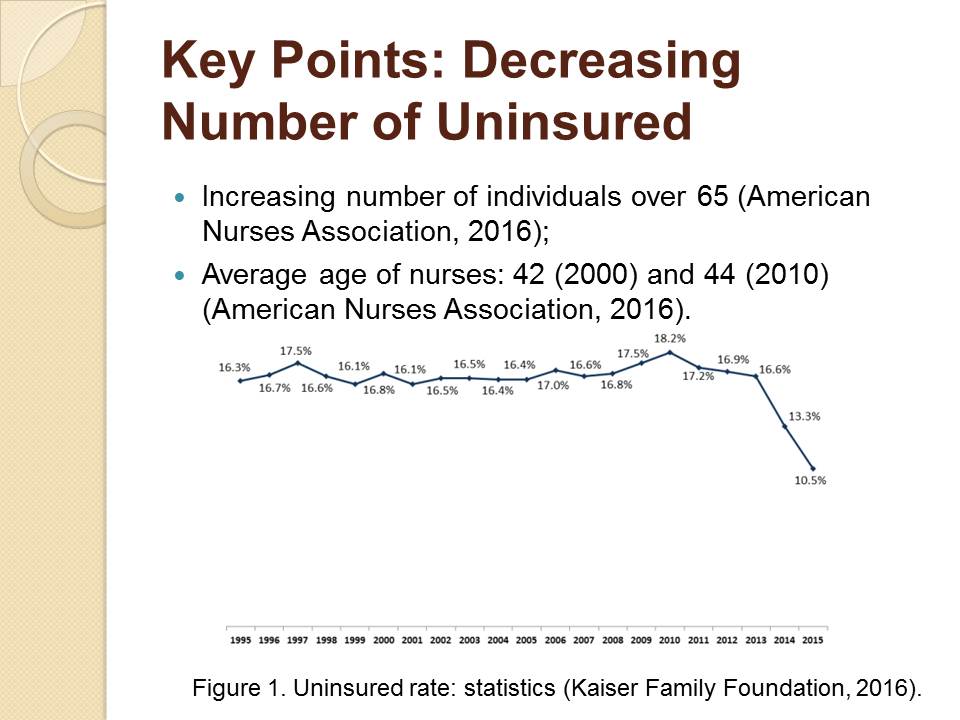
Key Points: Nursing Education
Another factor is high prices of nursing education since not all individuals can afford it. Subsequently, the percentage of nurses with the appropriate education is still low (below 80%) (Sheffield, 2016). Figure 2 displays that the number of nurses with bachelor degree experiences positive dynamics from 41% in 2000 to 80% in 2020 (Sheffield, 2016). This trend takes place due to the development of different legislation such as Nursing Workforce Reauthorization Act of 2017. Speaking of this act specifically, it mostly focuses on providing grants for advanced nursing education such as doctorate and master programs (US Senate Committee on Health, Education, Labor, and Pensions, 2017). It also offers financial support to the education of authorized clinical nurse specialists, but it is not enough due to the constantly rising demands for nurses. However, it is truly the first step in the right direction.
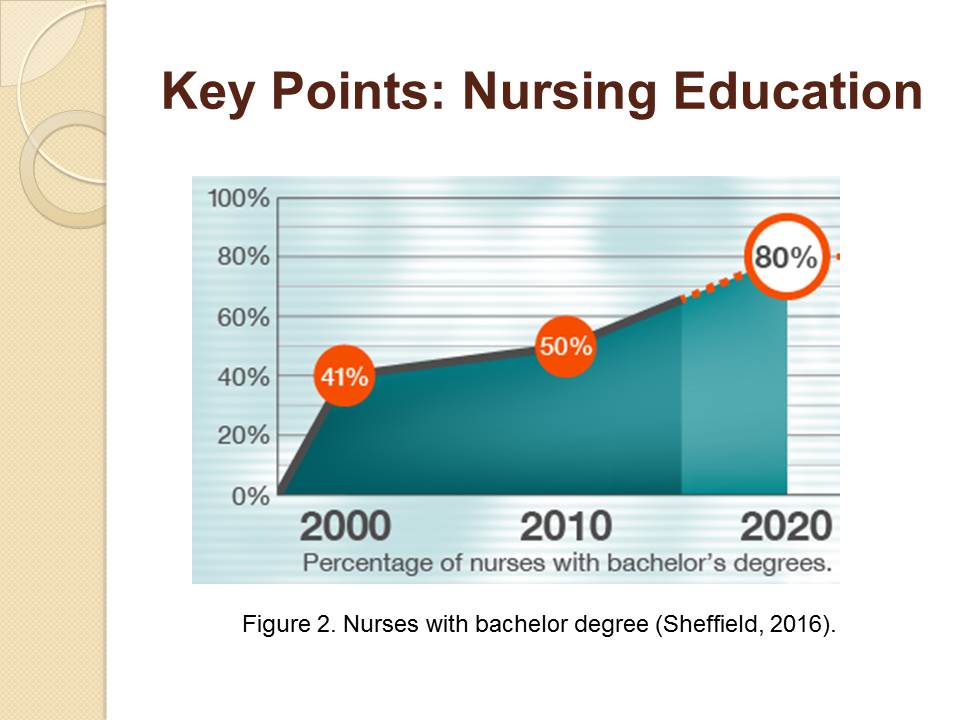
Key Points: Shortage of Nurses and Quality
Lastly, this issue is of paramount importance to resolve to diminish shortage. Currently, the existent situation has a negative impact on the patient-to-nurse ratio (from 4:1 to 8:1) (Sheffield, 2016). Meanwhile, it results in higher mortality rates due to the lower quality of provided services, as it is shown in Figure 3. Consequently, finding a solution will improve the overall quality of care in the country and increase levels of satisfaction among patients and nurses.
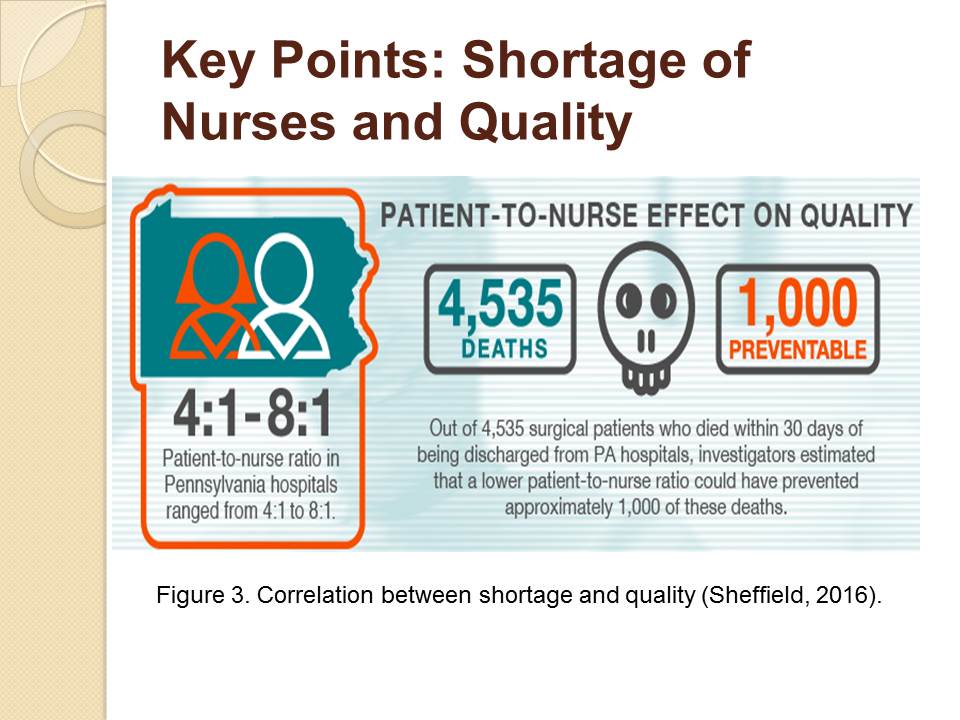
Potential Implications
- Unfavorable nurse-to-patient ratio (4:1) (Sheffield, 2016);
- High mortality rates;
- Negative impact on wellbeing and health of the nation;
- High levels of stress and burnout among nurses;
- Limitations to professional development.
As you have probably noticed, the lack of funding has a direct impact on the quality of the provided services, as a patient-to-nurse ratio has a tendency to be unfavorable (4:1) (Sheffield, 2016). As a consequence, it increases mortality rates while 1/5 of them tends to be preventable (Sheffield, 2016). A combination of these factors has an adverse impact on the wellbeing and health of the nation. As for nurses, this issue requires working extra hours, and, as a consequence, it shifts levels of stress and burnout rates. At the same time, on behalf of nursing professionals, I would like to state that this matter limits their possibilities for professional development. For example, the lack of funding prevents nurses from continuing education to become more qualified while prospective students do not have enough finances to become specialists. Overall, devoting more funding will assist in enhancing the quality of the provided services and help nurses reach their professional and individual goals.
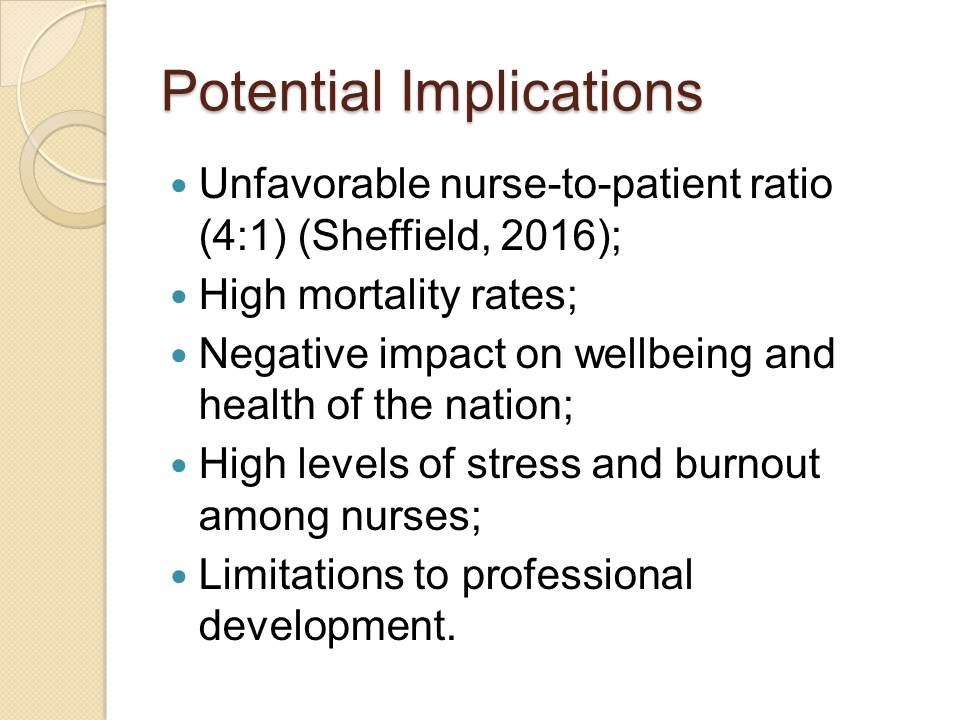
Conclusion
Lack of Financing:
- Professional development;
- National education levels;
- Nurse-to-patient ratio;
- Mortality rates;
- Quality of services.
As a future advanced nurse practitioner and social leader, I highly hope that this presentation helped you discover the profound insights of the subject. It clearly displayed that the lack of financing of nursing education (grants) not only affected professional development of nurses and level of education in the country but also had a vehement effect on the quality of the provided services, mortality rates, and nurse-to-patient ratio. Consequently, expanding Nursing Workforce Reauthorization Act of 2017 by paying more attention to bachelor education and grants for talented students will have to be discussed profoundly during subsequent meetings. It can help reduce nurse shortage, minimize stress levels, comply with rising demands for qualified professionals, and change perception of the United States in the global healthcare arena. Thank you for your attention, and if you have any questions, please, do not hesitate to ask!
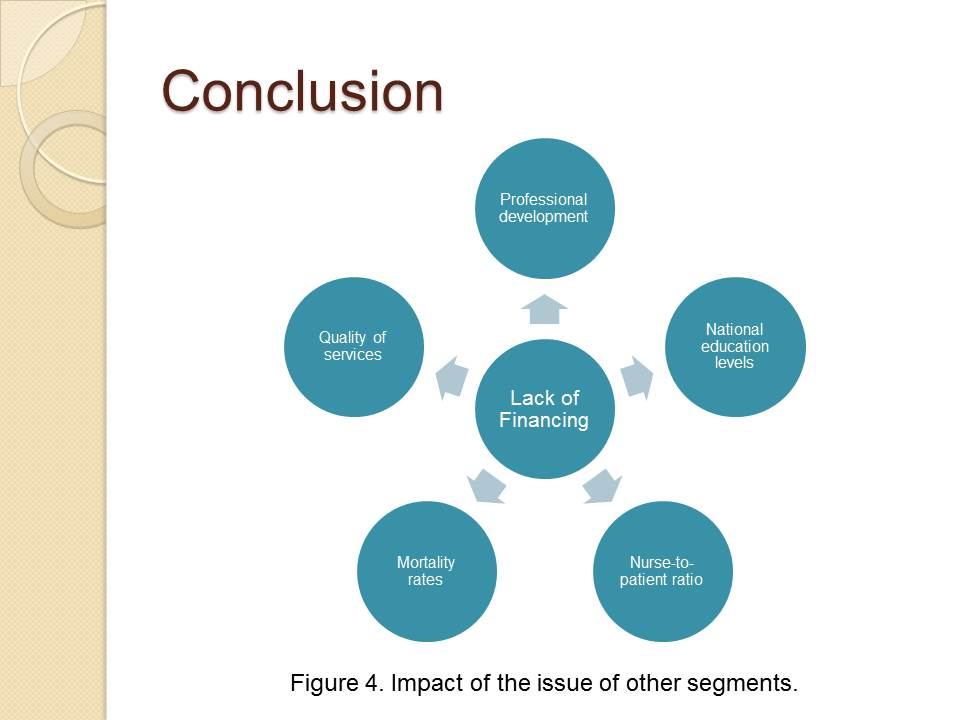
Revision of Nursing Workforce Reauthorization Act of 2017
- Continue supporting Master and Doctorate programs;
- Devote more financial resources to Bachelor degrees;
- Provide grants to talented students.
I selected this issue since its consequences not only influenced the working environment and professional development of nurses but also had a substantial influence on mortality rates and quality of healthcare. As a nurse with active social position, I believe that this issue has to be resolved. Expanding funding under Nursing Workforce Reauthorization Act of 2017 will help satisfy the needs of nurses and students while simultaneously addressing the aspects that pertain to its global consequences such as shortage of workforce and low quality of healthcare.
